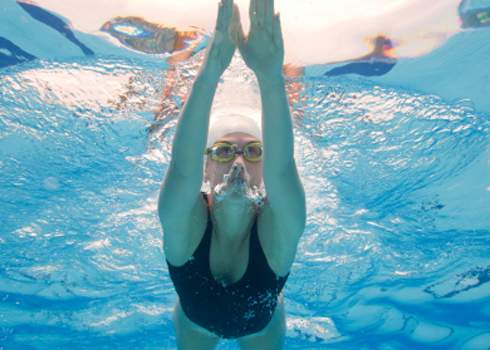In a year-round sport with only one championship every three or four months, it can be very easy to lose sight of the purpose for practice and end up just going through the motions. You put so much time into repeating the same movements that you don’t really think about them anymore. You put your body on autopilot and your mind drifts far away from the pool. But how does being so disconnected affect your performance?
Just going through the motions happens when you are physically doing everything you should, but mentally you are playing over the events of the day, worrying about what your best friend or your crush might be thinking, planning what you’ll do after practice or on the weekend, or any number of other possible scenarios that are anything but paying attention to your swimming. Sometimes your coaches cue you into what you should be thinking about. They’ll specifically ask for focus on pushoffs, turns, stroke technique, race strategy, pace, descend, max out, etc. But sometimes it seems like just another boring set. This is when you can practice bringing your mind to the motions.
You can start practicing mindfulness by honing in on your breathing—just the feeling and sound of exhaling fully underwater and simply drawing air in when your mouth exits the water. Or you can experience the rhythm of your stroke, the comfort of the water holding you up, the rush of the water past your ears, the miracle and craziness of hundreds of people swimming in circles and spaced just so. In other words, just be, and practice attention by gently drawing your mind back to your experience when it begins to wander away to all else in your life.
This is the start of learning how to focus, of learning how to channel your attention and energy where it needs to be when it needs to be there. Monotonous sets are not the only instigator of inquisitive minds. Peter Haberl, senior sport psychologist for the U.S. Olympic Committee, teaches mindfulness to the U.S. Olympic team due to the unique distractions present at the Olympic Games.
At all levels, swim meets can have a multitude of distractions that capture your mind and direct your attention away from your races. Maybe the team next to you is playing music loudly or publically displaying team drama. Maybe it is unusually hot or cold outside or the water tastes strange. Perhaps there is a lengthy delay due to technology or lightning and you are forced to re-warm up and be ready at a moment’s notice. These scenarios and more can throw you off your game if you let your thoughts ramble or exaggerate the significance of what has happened. The goal of mindfulness is to develop a sense of calm in the midst of the storm.
It is most helpful to cultivate mindfulness long before making the Olympic team or competing in your target meet. Next time you practice, become cognizant of what you are doing the moment you are doing it—your breath, your movement, your thoughts. Be present.
A helpful exercise is to image being able to watch yourself. My teammate Betsy Nagy once told me, “When I was little I thought it was like flying because you see the bottom of the pool, but you’re not on it.” You can try to sense your body flying through the water using only the propulsion of your arms and legs. I remember how it felt in high school to swim under a black star-studded sky, somewhat surreal as I flew through chilly liquid, over the black line, moving from my own effort. I remember recognizing this feeling as I experienced it. Try to recognize your time swimming as a special time, somehow just for you, in spite of all your teammates engaged in the same activity. In other words, become aware of your surroundings and your bodily movement, without thought and without judgment, but rather with an attitude of serenity, control, and even awe.
From awareness of yourself swimming in practice, you can move to awareness of yourself during the many elements of swim meets—preparation for warm-ups, warm-ups, the waiting period before an event, the event, response to the event, talking to your coach, warming down, and more. By remaining concerned only with the moment, you can reduce anxiety, distractions, fatigue, and pain.
It’s a huge challenge. Perhaps now is the perfect time to make it a regular part of your practice. When the pressure seems overwhelming and when the craziness of a swim meet steals your attention, back away mentally. When your goals seem far away and the set seems purposeless, seize the moment. Perhaps now is the time to quit letting the environment determine your performance and to start taking control of the present. Perhaps now is the time to quit just going through the motions and to start living them.
This article is reprinted with the express written consent of Swimming World.
Tonya Nascimento is a doctorate student in the sport psychology program at Florida State University. She was a competitive swimmer for 20 years, during which she swam for FSU. She also coached Maverick Aquatics for eight years and the Niceville High School swim team for four years.






